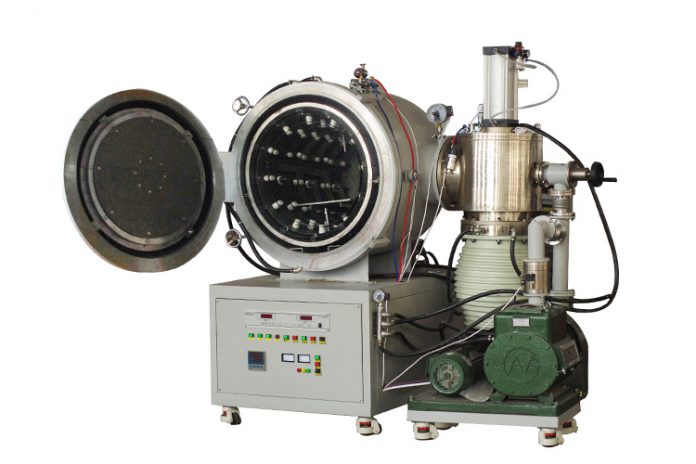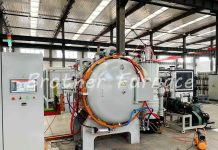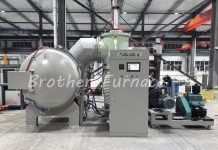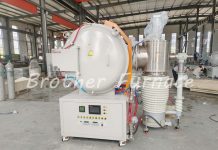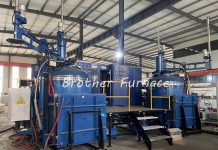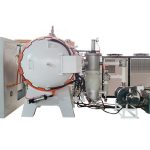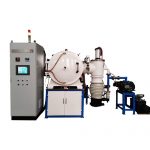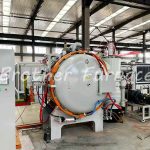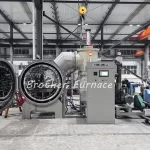Before we talk about the vacuum heat treatment process and vacuum furnace operation, let’s learn more about vacuum heat treatment.
What is vacuum heat treatment?
The material or workpiece to be treated is heated to a suitable temperature by resistance or induction in a vacuum or protective gas environment kept at a high temperature for a certain period of time, and then cooled at different rates in different cooling media, so as to change the surface or internal microstructure of the material or workpiece to be treated in order to eliminate and control certain defects and improve and enhance its performance and quality.
Vacuum heat treatment classification
Vacuum sintering: Vacuum heating at a temperature lower than the melting point of the basic components of the powder or powder billet, makes the powder particles solidify and become grain aggregates, and finally obtain a dense sintered body.
Vacuum brazing: The liquid brazing material with a lower melting point than the base metal is diffused by penetrating the tiny gap between the workpieces under vacuum heating, and fills the gap of the base metal to form a solid metal band.
Vacuum quenching: In the vacuum heating state of steel or alloy workpiece is heated to a certain temperature and maintained for a certain period of time, and then cooled sharply through the cooling medium, so that the workpiece from austenite to martensite tissue state, and to obtain an increase in hardness. The different cooling medium is divided into gas quenching, oil quenching, and water quenching.
Vacuum tempering: after quenching the workpiece in a vacuum at different temperatures for heating, holding, and cooling, to obtain a certain hardness and toughness of tempered martensite, tempered brittleness.
Vacuum annealing: the steel workpiece in a vacuum state for heating, holding and cooling with the furnace, so as to remove the internal stress generated by the work hardening so that the internal organization of the workpiece to reach or near equilibrium, enhance the elongation, improve plasticity.
Vacuum solution: stainless steel or alloy workpiece is heated to a certain temperature under vacuum, held, and cooled, so that the internal alloy phase of the workpiece is fully dissolved to form a change in tissue state and obtain a solid solution, eliminate stress, improve and enhance the plasticity, toughness and corrosion resistance of the workpiece in order to continue processing or forming.
Vacuum aging heat treatment: After solid melting treatment, stainless steel or alloy workpiece is heated to a certain temperature in a vacuum and then kept warm to make its performance, shape, and size change with time, so as to eliminate internal stress, stabilize organization and size, and improve mechanical properties.
Vacuum normalizing: Heating the steel workpiece above austenitizing temperature and holding it for a period of time and then cooling it slowly, so as to change the internal matrix organization of the workpiece.
Vacuum degassing: The workpiece is heated to a certain temperature under vacuum and held for a period of time to allow the release of impurity gases inside the workpiece to inhibit aging embrittlement and improve mechanical properties.
Magnetic annealing: A heat treatment process to remove the internal stress of soft magnetic materials due to calendering or stamping process.
Dehydroxylation: Through a long time of high temperature roasting and exhausting under a high vacuum, the hydroxyl impurities inside the quartz workpiece are released to improve the quality and service life of the workpiece.
Comparison of vacuum heat treatment and non-vacuum heat treatment
Advantages of vacuum heat treatment: clean treatment environment, no oxidation and decarburization, degreasing and degassing; inhibition of volatilization of metal elements inside the workpiece, surface brightening, small quenching deformation, improved wear resistance, fatigue strength, and machinability, stable process with repeatability, energy-saving and environmental protection, easy cost recovery.
Controlled atmosphere heat treatment: the surface of the workpiece after treatment is rough, not bright, lacks surface metal elements; erosion of electric heating elements; the amount of gas used, reducing gas recovery processing difficulties.
Ordinary atmosphere heat treatment: the surface of the workpiece exists oxide film, the treatment environment is harsh, narrow use.
Vacuum furnace operation process (general)
- Open the vacuum furnace door and charge the furnace. Close the door and make sure the furnace chamber seal is intact.
- Check the manual vacuum valves to make sure they are closed.
- Feed the main power supply and the control display lights up.
- Turn on the water cooler, enter the required water temperature on the water cooler operation interface and start the water cooling system (see the water cooler operation manual for details).
- Open the exhaust port on the rotary vane pump to ensure gas circulation. (After the rotary vane pump is used, seal the exhaust port to avoid debris entering the rotary vane pump.) Make sure the diffusion pump and rotary vane pump valves are closed.
- Start the rotary vane pump and diffusion pump on the touch screen operation interface.
- Slowly rotate to open the rotary vane pump valve to avoid the exhaust port from spraying oil due to excessive air volume.
- After the rotary vane pump and diffusion pump run for about 1 hour and the display on the right side of the vacuum, gauge shows less than 100Pa, close the rotary vane pump valve and open the diffusion pump valve.
- Close the vacuum pump set after the vacuum gauge display reaches the required vacuum degree and starts to heat up. (Vacuum pump set-closing process: close the diffusion pump valve first → stop diffusion pump → stop rotary vane pump after 40 minutes) also can be heated during the vacuum pumping process.
- Enter the required process requirements on the heating operation interface and start heating.
- After the heating process is stopped, (if the vacuum is added to the process, wait for the vacuum furnace chamber temperature to drop to a suitable temperature for the process, close the vacuum pumping unit, close the process as above) diffusion pump temperature drop. To the touchable temperature before closing the water cooler.
- When the furnace temperature drops to room temperature, open the bleeder valve, and wait for the internal air pressure of the furnace chamber to atmospheric pressure.
- Open the furnace door and take out the material.
- After taking out the material, clean the inside of the vacuum furnace chamber, keep the door closed when not in use for a long time, and keep the vacuum inside the chamber.
Contact us if you need the detailed vacuum furnace operation manual.
Check out our Vacuum Furnaces:
- Vacuum Brazing Furnace
- Vacuum Furnace up to 1700℃
- Vacuum Induction Melting Furnace
- Graphite Vacuum Furnace up to 2200℃
- Vacuum Hot Press Furnace
Follow us on Facebook

